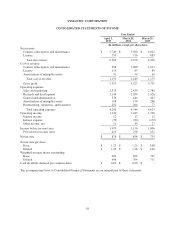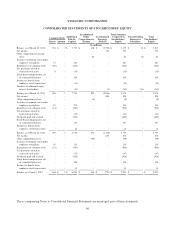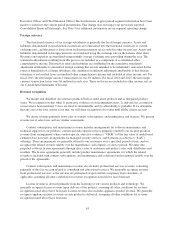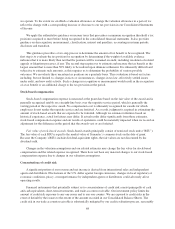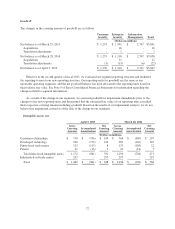Symantec 2015 Annual Report Download - page 140
Download and view the complete annual report
Please find page 140 of the 2015 Symantec annual report below. You can navigate through the pages in the report by either clicking on the pages listed below, or by using the keyword search tool below to find specific information within the annual report.SYMANTEC CORPORATION
Notes to Consolidated Financial Statements
Note 1. Summary of Significant Accounting Policies
Business
Symantec Corporation (“we,” “us,” “our,” and “the Company” refer to Symantec Corporation and all of its
subsidiaries) is an information protection expert that helps people, businesses and governments seeking the
freedom to unlock the opportunities technology brings – anytime, anywhere.
On October 9, 2014, we announced plans to separate our business into two independent publicly-traded
companies: one focused on security and one focused on information management. The transaction is intended to
take the form of a tax-free distribution to Symantec shareholders of all of the capital stock of our information
management business. We expect to complete the legal separation on January 2, 2016, subject to market,
regulatory and certain other conditions. John Gannon has been appointed as General Manager of the information
management business, and Don Rath has been appointed as acting Chief Financial Officer. After the transaction,
Michael Brown and Thomas Seifert will continue to lead Symantec as Chief Executive Officer and Chief
Financial Officer, respectively. For additional separation cost information, see Note 6.
Principles of consolidation
The accompanying consolidated financial statements of Symantec Corporation and its wholly-owned
subsidiaries are prepared in conformity with generally accepted accounting principles (“GAAP”) in the United
States (“U.S.”). All significant intercompany accounts and transactions have been eliminated. Certain amounts in
the 2014 and 2013 Consolidated Financial Statements within operating expenses have been reclassified to be
comparable with classifications used in our 2015 Consolidated Financial Statements.
Fiscal calendar
We have a 52/53-week fiscal year ending on the Friday closest to March 31. Our fiscal 2015 was a 53-week
year whereas our fiscal 2014 and 2013 were 52-week years.
Use of estimates
The preparation of consolidated financial statements in conformity with U.S. GAAP requires management
to make estimates and assumptions that affect the amounts reported in the consolidated financial statements and
accompanying notes. Estimates are based upon historical factors, current circumstances and the experience and
judgment of management. Management evaluates its assumptions and estimates on an ongoing basis and may
engage outside subject matter experts to assist in its valuations. Actual results could differ from those estimates.
Significant items subject to such estimates and assumptions include those related to the allocation of revenue
recognized and deferred amounts, valuation of goodwill, intangible assets and long-lived assets, valuation of
stock-based compensation, contingencies and litigation, and the recognition and measurement of current and
deferred income taxes (including the measurement of uncertain tax positions).
Segment reporting change
In fiscal 2015, we focused on managing our businesses as a portfolio and optimizing certain businesses for
margin or growth. As a result, beginning from the second quarter of fiscal 2015, we modified our segment
reporting structure to match our new operating structure and how our Chief Operating Decision Maker
(“CODM”) reviews the business and allocates resources. The CODM function is comprised of our Chief
62








